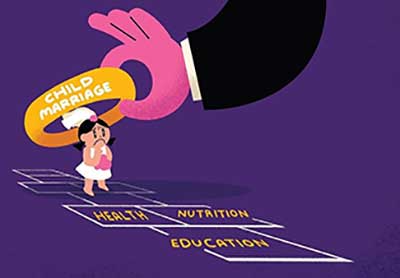Relevance: GS-1: Salient features of Indian Society, Role of women, Social empowerment.
Key Phrases: NFHS-5 data, Adivasis, Dalits, economically disadvantaged, ante-natal care, public health dividends, educational opportunities,
Context:
- Since child marriage is rampant in India, the debate on whether increasing the age of marriage for women will solve this issue or not is going on.
Background:
- The Prohibition of Child Marriage Act, 2006 prohibits solemnization of marriage of a boy who is less than 21 years of age and a girl who is less than 18 years of age.
- A 2015-2016 UNICEF report estimated that India's child marriage rate is 27%.
- Child marriage was outlawed in 1929, under Indian law. However, in the British colonial times, the legal minimum age of marriage was set at 14 for girls and 18 for boys.
Data showing Child Marriages in India:
- NFHS-5 data show that about 25% of women aged 18-29 years married before the legal marriageable age of 18.
- The proportion has declined only marginally from NFHS-4 (28%). Expectedly, the prevalence is higher in rural than urban India (28% and 17%, respectively).
- West Bengal has the highest prevalence (42%), followed by Bihar and Tripura (40% each).
- Oddly, the decline in child marriage has been paltry at best in these high-prevalence States.
- At the other end of the spectrum are Goa, Himachal Pradesh and Kerala (6% to 7%).
- If we look at the data community-wise, 39% of child marriages in India take place among Adivasis and Dalits.
- The share of advantaged social groups is 17% and the remaining share is of Other Backward Classes.
- In terms of household wealth, 58% of these marriages take place among the poorest wealth groups (bottom 40%), about 40% of them take place among the middle 50% and only 2% of them take place among the top 10% of wealth groups.
- Only 4% of child marriages in India take place among women who have completed more than 12 years of education.
- Thus, the data confirm that a significant proportion of child marriages takes place among women with less than 12 years of schooling and households that are socially and economically disadvantaged.
Need for Increasing age limit for marriage for girls:
- Several empirical studies from South Asia establish a significant association between early marriage and adverse health and educational outcomes for women and their children.
- Specifically, studies associate early marriage of women with early pregnancy, lower likelihood of accessing antenatal care, higher risks of maternal morbidity and mortality, poor nutritional status of women, and poor nutritional and educational outcomes for children.
- These studies seem to provide a rather compelling case for increasing the age of marriage of women from 18 to 21 years, as a delayed marriage might offer significant public health dividends.
Factors behind Child marriage:
- Social Norms:
- It is because of social norms in many regions and cultures that parents begin preparations for a girl’s marriage once she has reached menarche.
- Because marriage often determines a woman’s status in many societies, parents also worry that if they don’t marry their daughters according to social expectations, they will not be able to marry them at all.
- Forced child marriage also is a route to cementing family, clan, and tribal connections or settling obligations.
- Poverty:
- Equally, a large proportion of child marriages take place primarily because of poverty and the burden of the huge costs of dowry associated with delayed marriages.
- These factors curtail a girl’s opportunities to continue her education.
- And in turn, the lack of educational opportunities plays an important role in facilitating child marriage.
- Insecurity in the Face of conflict:
- When families live in unsafe regions, parents may genuinely believe that marrying their daughters is the best way to protect them from danger.
- Limited education:
- Little or no schooling strongly correlates with being married at a young age. Conversely, attending school and having higher levels of education protect girls from the possibility of early marriage.
Various initiatives by Indian Govt.:
- Prohibition of Child Marriage Act: The Government has enacted the ‘Prohibition of Child Marriage Act (PCMA), 2006’ for prohibition of solemnisation of child marriages and for matters connected therewith or incidental thereto.
- Beti Bachao Beti Padhao: The Ministry of Women and Child Development implements the ‘Beti Bachao Beti Padhao (BBBP)’ scheme, wherein women and society at large are made aware about gender equality and ill effects of child marriages.
- CHILDLINE: Government of India has introduced CHILDLINE with short code 1098, a 24X7 telephone emergency outreach service for children in crisis, which responds with suitable interventions to calls for any form of assistance which a child requires, including for prevention of child marriages in coordination with police, CMPOs, District Child Protection Units etc.
Conclusion:
- Girls in all their diversity must be at the centre of solutions to end child marriage. Families and communities must be engaged in transforming the negative social norms that limit girls’ choices.
- By working together, we can extend gender equality in the home and in public spaces, so that girls can reach their full potential.
Sources: The Hindu
Mains Question:
Q. Since child marriage is rampant in India, will increasing the age of marriage of women solve this issue? Discuss (250 words).







